Impact of Climate Change on the Climatic Suitability of Oilseed Rape (Brassica napus L.) Planting in Jiangsu Province, China
Abstract
1. Introduction
2. Data and Methods
2.1. Overview of the Study Area
2.2. Data Source
- (1)
- Surface meteorological data: The National Climate Center of China provides the daily surface climatic data, including the mean temperature, sunlight hours, and precipitation from 1969 to 2018 in Jiangsu Province (Figure 1). For data quality control, linear interpolation was used to fill missing data with durations ≤ 3 days; for missing data exceeding 3 days, values were replaced with the mean from neighboring observation stations (selected by geographical proximity and similar observational conditions). The reliability of these filling methods was validated via cross-validation.
- (2)
- Future climate scenario data: The future scenario meteorological data from 2024 to 2050 in the province are from the simulated meteorological data (temperature and precipitation) under the SSP2-4.5 scenario in the CMIP6 scenario. The data were downloaded from https://aims2.llnl.gov/search/cmip6/ (accessed on 15 June 2024).
- (3)
- DEM data: The digital elevation model data (30 m × 30 m) for the province were collected from https://www.gscloud.cn/.
- (4)
- The 1:250,000 administrative region vector map of the province includes the provincial boundary and the boundaries of 13 cities and counties. The data were collected from https://www.resdc.cn/.
2.3. Methodology
2.3.1. Framework Flowchart
2.3.2. Univariate Linear Trend Analysis
2.3.3. Anomaly Analysis
2.3.4. Mann–Kendall Test Method (M–K Test)
2.3.5. Inverse Distance Weighting Interpolation Method
2.3.6. Spatial Modeling of Meteorological Data
2.3.7. Climate Suitability Model
- (1)
- Temperature suitability model
- (2)
- Sunlight suitability model
- (3)
- Precipitation suitability model
- (4)
- Comprehensive climate suitability model
3. Results
3.1. Spatiotemporal Variability of Climatic Suitability for Oilseed Rape in Jiangsu During the Past Five Decades
3.1.1. Temperature Suitability
3.1.2. Precipitation Suitability
3.1.3. Sunlight Suitability
3.1.4. Comprehensive Suitability
3.2. Projected Changes in Climatic Suitability for Oilseed Rape Planting Under Climate Scenarios in Jiangsu Province
3.2.1. Climate Suitability Projection for Oilseed Rape Under Future Climate Conditions
3.2.2. Evaluation of Future Comprehensive Suitability for Oilseed Rape in Jiangsu and the Potential Variation
4. Discussion
5. Conclusions
Author Contributions
Funding
Data Availability Statement
Conflicts of Interest
References
- Liu, C.; Feng, Z.C.; Xiao, T.H.; Ma, X.M.; Zhou, G.S.; Huang, F.H.; Li, J.N.; Wang, H.Z. Development, potential and adaptation of Chinese oilseed rape industry. Chin. J. Oil Crop Sci. 2019, 41, 485–489. (In Chinese) [Google Scholar]
- Fu, D.H.; Jiang, L.Y.; Mason, A.S.; Mei, L.X.; Long, R.Z.; Li, Z.; LI, D.; Qing, H.Z.; Chang, J.S.; Chun, H.H. Research progress and strategies for multifunctional Oilseed rape: A case study of China. J. Integr. Agric. 2016, 15, 1673–1684. [Google Scholar] [CrossRef]
- Huang, J.; Zhou, L.; Zhang, F.; Hu, Z.; Li, Y. Regional climate–yield relationship for winter oilseed rape in Jiangsu Province, Southeast China. Int. J. Plant Prod. 2019, 13, 93–102. [Google Scholar] [CrossRef]
- Wang, H. Strategy for oilseed rape industry development based on the analysis of oilseed rape production and demand in China. Chin. J. Oil Crop Sci. 2007, 29, 101. (In Chinese) [Google Scholar]
- Lee, H.; Calvin, K.; Dasgupta, D.; Krinner, G.; Mukherji, A.; Thorne, P.; Trisos, C.; Romero, J.; Aldunce, P.; Barrett, K.; et al. Climate Change 2023: Synthesis Report. Contribution of Working Groups I, II and III to the Sixth Assessment Report of the Intergovernmental Panel on Climate Change; IPCC: Geneva, Switzerland, 2023. [Google Scholar]
- Fedoroff, N.V.; Battisti, D.S.; Beachy, R.N.; Cooper, P.J.M.; Fischhoff, D.A.; Hodges, C.N.; Knauf, V.C.; Lobell, D.; Mazur, B.J.; Molden, D.; et al. Radically rethinking agriculture for the 21st century. Science 2010, 327, 833–834. [Google Scholar] [CrossRef] [PubMed]
- Challinor, A.J.; Ewert, F.; Arnold, S.; Simelton, E.; Fraser, E. Crops and climate change: Progress, trends and challenges in simulating impacts and informing adaptation. J. Exp. Bot. 2009, 60, 2775–2789. [Google Scholar] [CrossRef]
- Deng, Z.Y.; Zhang, Q.; Pu, J.Y.; Liu, D.X.; Guo, H.; Wang, Q.F.; Zhao, H.; Wang, H.L. The impact of climate warming on crop planting and production in northwestern China. Acta Ecol. Sin. 2008, 28, 3760–3768. [Google Scholar]
- Yujie, W.; Botao, Z.; Chenghu, S. Impacts of global climate change on China’s climate security. J. Appl. Meteorol. Sci. 2016, 27, 750–758. (In Chinese) [Google Scholar]
- Xu, L.L.; Lv, H.Q.; Fang, L. Effect of climate change on the climate suitability of summer maize on the Huang-Huai-Hai Plain. Resour. Sci. 2014, 36, 782–787. (In Chinese) [Google Scholar]
- Ruijiang, W.; Xin, W. Progress and prospects of research on climatic suitability at home and abroad. Adv. Earth Sci. 2019, 34, 584. (In Chinese) [Google Scholar]
- Jianjun, Z.; Xiaoyi, C.; Xiaoqun, M. Establishment and application of climatic suitability indicator of rape in Anhui Province. Chin. Agric. Sci. Bull. 2012, 28, 155–158. (In Chinese) [Google Scholar]
- Wu, L.; Lou, W.; Liu, M.; Wu, Y. Changes of precipitation suitability and assessment of yield loss risk of cole at flowering period. Sci. Agric. Sin. 2011, 44, 620–626. (In Chinese) [Google Scholar]
- Huailiang, L.; Ning, Y. Study on climatic suitability for planting and effect of crop planting activities on climatic suitability: A case study of Yanting County, Sichuan Province. China 2016, 36, 7. (In Chinese) [Google Scholar]
- Khan, A.M.; Li, Q.; Saqib, Z.; Khan, N.; Habib, T.; Khalid, N.; Muhammad, M.; Aqil, T. MaxEnt modelling and impact of climate change on habitat suitability variations of economically important Chilgoza Pine (Pinus gerardiana Wall.) in South Asia. Forests 2022, 13, 715. [Google Scholar] [CrossRef]
- Läderach, P.; Martinez-Valle, A.; Schroth, G.; Castro, N. Predicting the future climatic suitability for cocoa farming of the world’s leading producer countries, Ghana and Côte d’Ivoire. Clim. Change 2013, 119, 841–854. [Google Scholar]
- Alsafadi, K.; Bi, S.; Abdo, H.G.; Almohamad, H.; Alatrach, B.; Srivastava, A.K.; Motrih, A.-M.; Santanu Kumar., B.; Chandran, M.A.S.; Mohammed, S. Modeling the impacts of projected climate change on wheat crop suitability in semi-arid regions using the AHP-based weighted climatic suitability index and CMIP6. Geosci. Lett. 2023, 10, 20. [Google Scholar] [CrossRef]
- Yebeyen, D.; Nemomissa, S.; Hailu, B.T.; Zewdie, W.; Sileshi, G.W.; Rodríguez, R.L.; Woldie, T.M. Modeling and mapping habitat suitability of highland bamboo under climate change in Ethiopia. Forests 2022, 13, 859. [Google Scholar] [CrossRef]
- Huang, J.; Zhou, L.; Zhang, F.; Hu, Z. Quantifying the effect of temporal variability of agro-meteorological disasters on winter oilseed rape yield: A case study in Jiangsu province, southeast China. Environ. Monit. Assess. 2019, 191, 276. [Google Scholar] [CrossRef]
- Wang, Y.; Lu, J.W.; Li, X.; Ren, T.; Cong, R.H.; Jiang, L.J.; Zhang, Y.C. Appropriate nitrogen fertilizer application rate for winter oilseed rape in main producation areas of Jiangsu and Zhejiang Provinces. Acta Pedol. Sin. 2013, 50, 1117–1128. (In Chinese) [Google Scholar]
- Rivas-Martínez, S.; Rivas-Sáenz, S.; Penas, A.S. Worldwide bioclimatic classification system. Glob. Geobot. 2011, 1, 1–634. [Google Scholar]
- Han, H.; Li, Z. Review of Quality Control Methods of Surface Real Time Meteorological Data. J. Arid. Meteorol. 2012, 30, 261–265. [Google Scholar]
- Jones, P.D. Hemispheric surface air temperature variations: Recent trends and an update to 1987. J. Clim. 1988, 1, 654–660. [Google Scholar] [CrossRef]
- Wang, J. Determining the most accurate program for the Mann-Kendall method in detecting climate mutation. Theor. Appl. Climatol. 2020, 142, 847–854. [Google Scholar] [CrossRef]
- Gocic, M.; Trajkovic, S. Analysis of changes in meteorological variables using Mann-Kendall and Sen’s slope estimator statistical tests in Serbia. Glob. Planet. Change 2013, 100, 172–182. [Google Scholar] [CrossRef]
- Wu, J.; Cheng, Y.; Mu, Z.; Dong, W.; Zheng, Y.; Chen, C.; Wang, Y. Temporal spatial mutations of soil erosion in the middle and lower reaches of the Lancang River Basin and its influencing mechanisms. Sustainability 2022, 14, 5169. [Google Scholar] [CrossRef]
- Burrough, P.A.; McDonnell, R.A.; Lloyd, C.D. Principles of Geographical Information Systems; Oxford University Press: Oxford, UK, 2015. [Google Scholar]
- Jiang, Y.; Huang, A.; Wu, H.; Zhang, X. GIS-based research on climate suitable region of Loquat in Lishui, Zhejiang province of China. Environ. Res. Commun. 2022, 4, 015006. [Google Scholar] [CrossRef]
- Wang, T. Research on the Impact of Climate Change on China’s Rape Production. Master‘s Thesis, Huazhong Agriculture University, Wuhan, China, 2021. (In Chinese). [Google Scholar]
- Chen, Y.; Ren, L.; Lou, Y.; Tang, L.; Yang, J.; Su, L. Effects of climate change on climate suitability of green orange planting in Hainan Island, China. Agriculture 2022, 12, 349. [Google Scholar] [CrossRef]
- Wei, S.; Li, K.; Yang, Y.; Wang, C.; Liu, C.; Zhang, J. Comprehensive climatic suitability evaluation of peanut in Huang-Huai-Hai region under the background of climate change. Sci. Rep. 2022, 12, 11350. [Google Scholar] [CrossRef] [PubMed]
- Zhu, M. Effects of Climate Change on the Climatic Resources and Suitability of Oilseed Rape in Jiangsu Province. Ph.D. Thesis, Nanjing University of Science & Technology, Nanjing, China, 2023. (In Chinese). [Google Scholar]
- He, Y.; Revell, B.J.; Leng, B.; Feng, Z. The effects of weather on oilseed rape (OSR) yield in China: Future implications of climate change. Sustainability 2017, 9, 418. [Google Scholar] [CrossRef]
- Zhang, Z.; Lu, J.; Cong, R.; Ren, T.; Li, X. Evaluating agroclimatic constraints and yield gaps for winter oilseed rape (Brassica napus L.)—A case study. Sci. Rep. 2017, 7, 7852. [Google Scholar] [CrossRef]
- Zhao, J.; Zhan, X.; Jiang, Y.; Xu, J. Variations in climatic suitability and planting regionalization for potato in northern China under climate change. PLoS ONE 2018, 13, e0203538. [Google Scholar] [CrossRef]
- Pullens, J.W.M.; Sharif, B.; Trnka, M.; Balek, J.; Semenov, M.A.; Olesen, J.E. Risk factors for European winter oilseed rape production under climate change. Agric. For. Meteorol. 2019, 272, 30–39. [Google Scholar] [CrossRef]
- Wang, B.; Liu, J.; Kim, H.J.; Webster, P.J.; Yim, S.Y. Recent change of the global monsoon precipitation (1979–2008). Clim. Dyn. 2012, 39, 1123–1135. [Google Scholar] [CrossRef]
- Jiang, J.; Zhang, J.; Li, Y.; Zhu, J.; Wang, W.; Lei, L.; Zhou, X.; Yang, L. Screening and identification of low-temperature germination and Freeze Resistant Germplasm at Seedling Stage of Oilseed rape. Mol. Plant Breed. 2025, 1–13. (In Chinese) [Google Scholar]
- Lei, Y.; Liu, Z.; Yan, L.; Ding, X.Y.; Cheng, Y.; Zhan, Q.; Wang, X.Y.; Bao, W.Z.; Li, X.F.; Zou, X.L. Physiological and biochemical response of growth in oilseed rape (Brassica napus L.) under low temperature. Chin. J. Oil Crop Sci. 2021, 43, 1061–1069. (In Chinese) [Google Scholar]
- Li, S.; Wan, L.; Li, X.-h.; Ni, M.A.; Jun, L.I.; Zhang, C.-l. Physiological response of 3 Brassica species to drought stress. Chin. J. Oil Crop Sci. 2020, 42, 563. (In Chinese) [Google Scholar]
- Yang, W. Response of oilseed rape to waterlogging and drainage index determination. J. Irrig. Drain. 2016. [Google Scholar]
- Tian, Z.; Ji, Y.; Sun, L.; Xu, X.; Fan, D.; Zhong, H.; Liang, Z.R.; Gunther, F. Changes in production potentials of oilseed rape in the Yangtze River Basin of China under climate change: A multi-model ensemble approach. J. Geogr. Sci. 2018, 28, 1700–1714. [Google Scholar] [CrossRef]
- Takashima, N.E.; Rondanini, D.P.; Puhl, L.E.; Puhl, L.E.; Miralles, D.J. Environmental factors affecting yield variability in spring and winter oilseed rape genotypes cultivated in the southeastern Argentine Pampas. Eur. J. Agron. 2013, 48, 88–100. [Google Scholar] [CrossRef]
- Wang, Y.; Zhang, X.; Jiang, H.; Zhang, Y.N.; Lin, Y.Y.; Rao, X.Q. Light stress diagnosis of oilseed rape seedling stage based on hyperspectral imaging technology. J. Zhejiang Univ. (Agric. Life Sci.) 2022, 48, 106–116. (In Chinese) [Google Scholar]
- Brown, J.K.M.; Beeby, R.; Penfield, S. Yield instability of winter oilseed rape modulated by early winter temperature. Sci. Rep. 2019, 9, 6953. [Google Scholar] [CrossRef] [PubMed]
- Qin, Z.H.; Tang, H.J.; Li, W.J. Front issues in studying the impacts of climate change on grain farming system in China. Chin. J. Agric. Resour. Reg. Plan. 2015, 36, 1–8. (In Chinese) [Google Scholar]
- Yao, X. Effects of Spring Precipitation on Growth and Yield Formation of Winter Rape in Tianshui. J. Anhui Agric. Sci. 2020, 48, 229–231+255. (In Chinese) [Google Scholar]
- Min, J.; Gao, C.; Chang, Z.; Zhang, F.M.; Huang, J. Potential effect of abnormal spring precipitation on winter oilseed rape yield in Jiangsu Province during recent 50 years. Acta Agric. Jiangxi 2019, 31, 104–109. (In Chinese) [Google Scholar]
- Meng, H.; Qian, L.; Duan, K. Evaluating the impacts of flooding on crop yields by different meteorological indices: A regional case study in the middle-lower reach of the Yangtze River, China. Ecol. Indic. 2024, 162, 112068. [Google Scholar] [CrossRef]
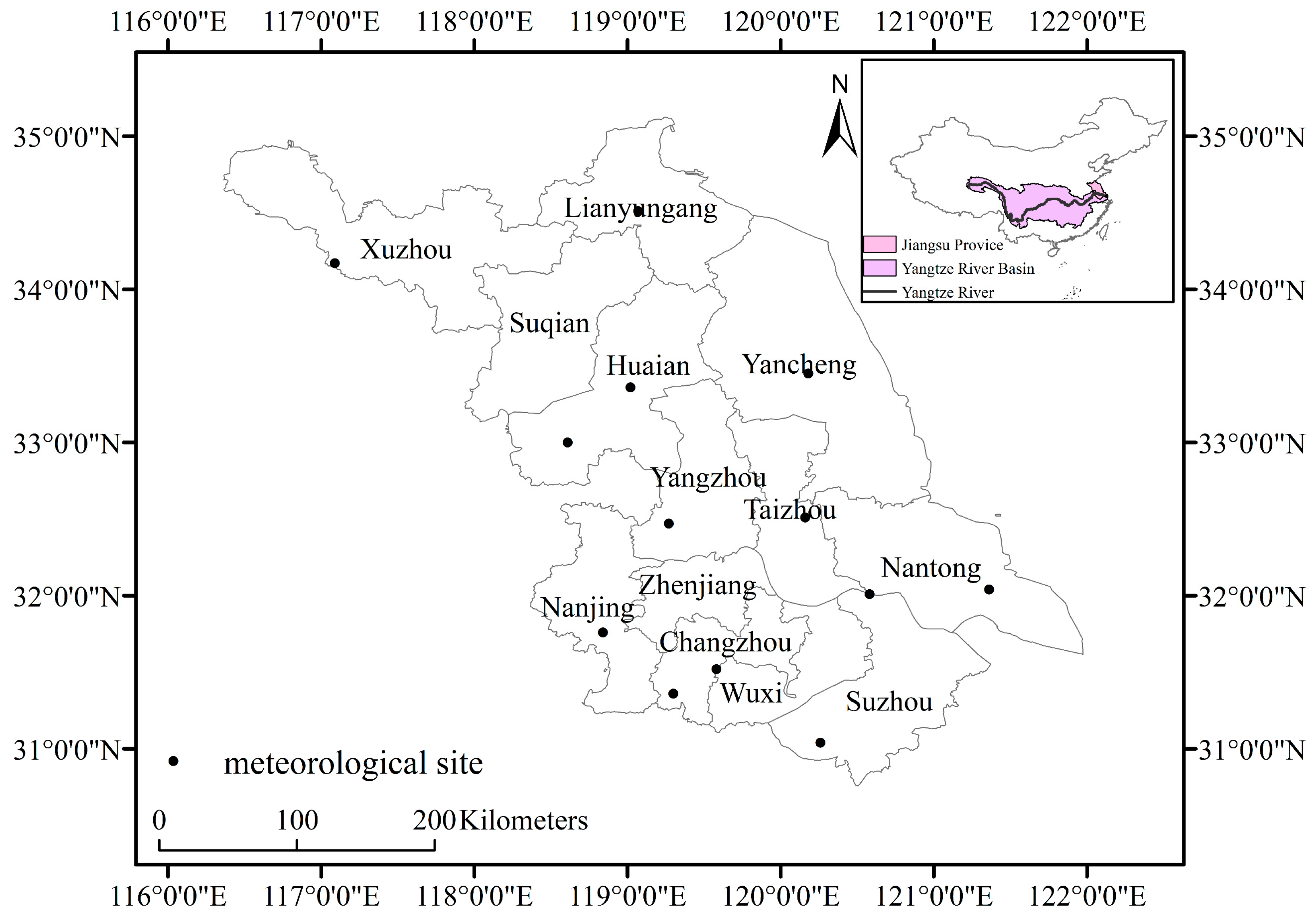
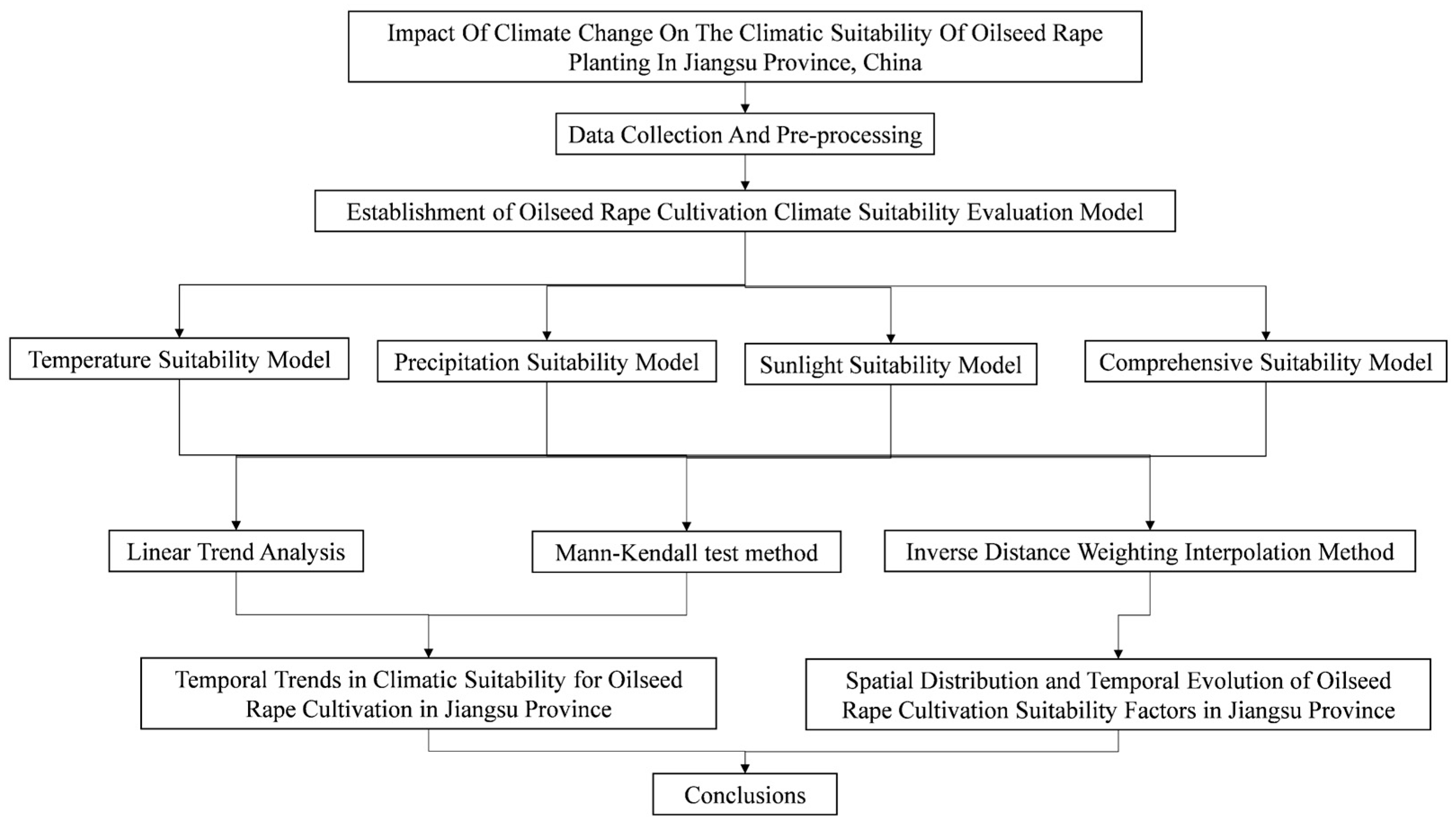
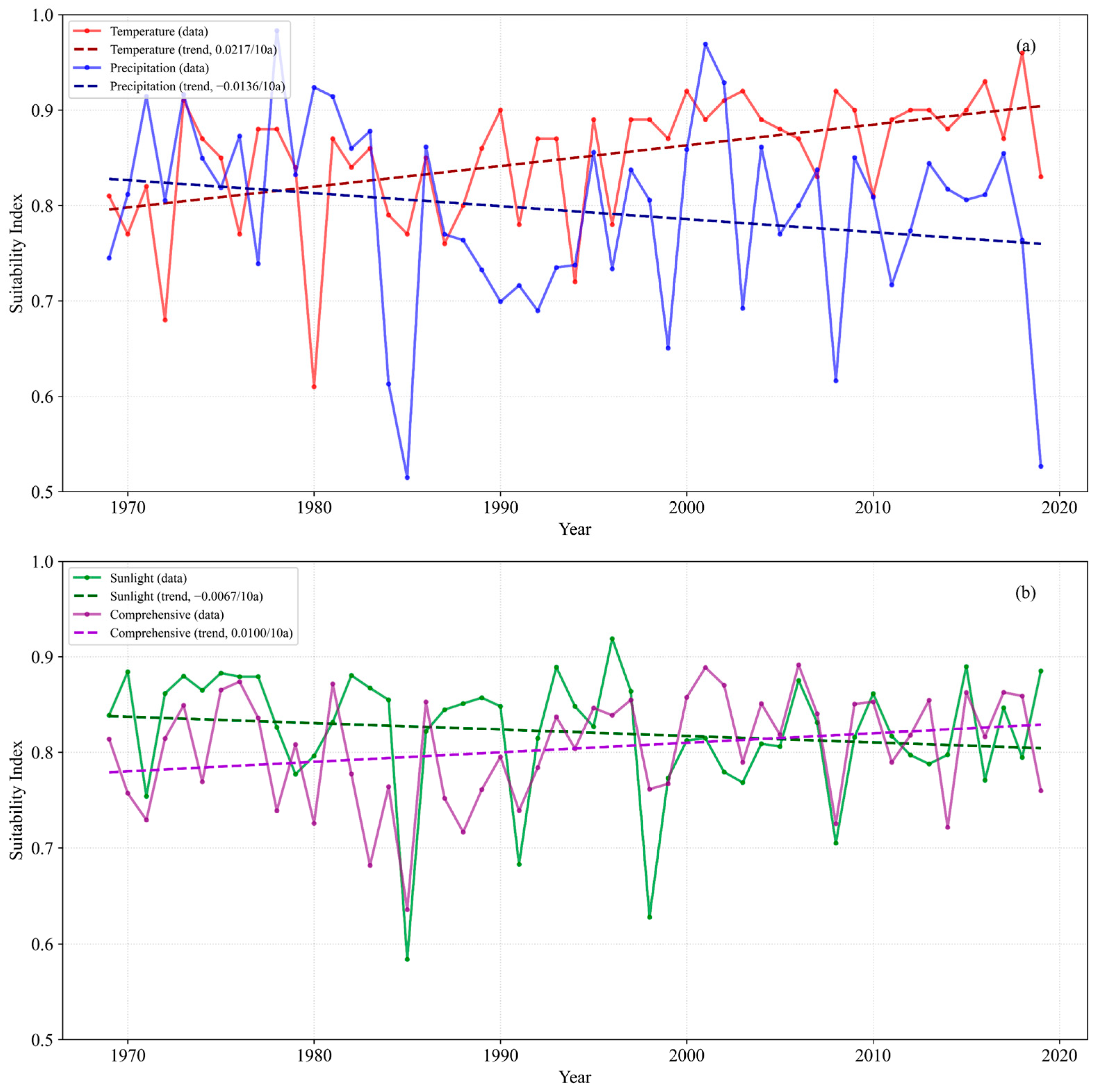

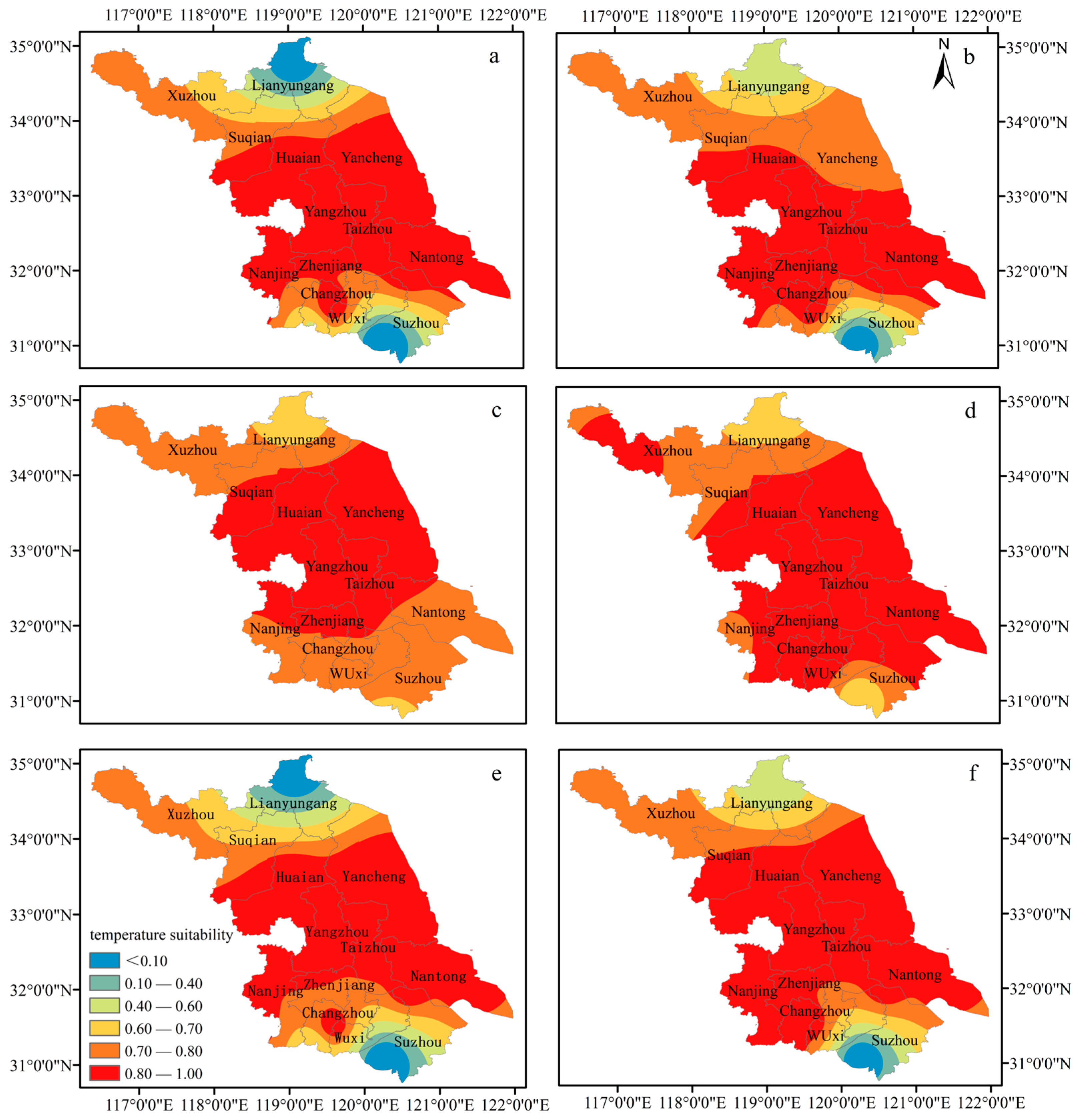
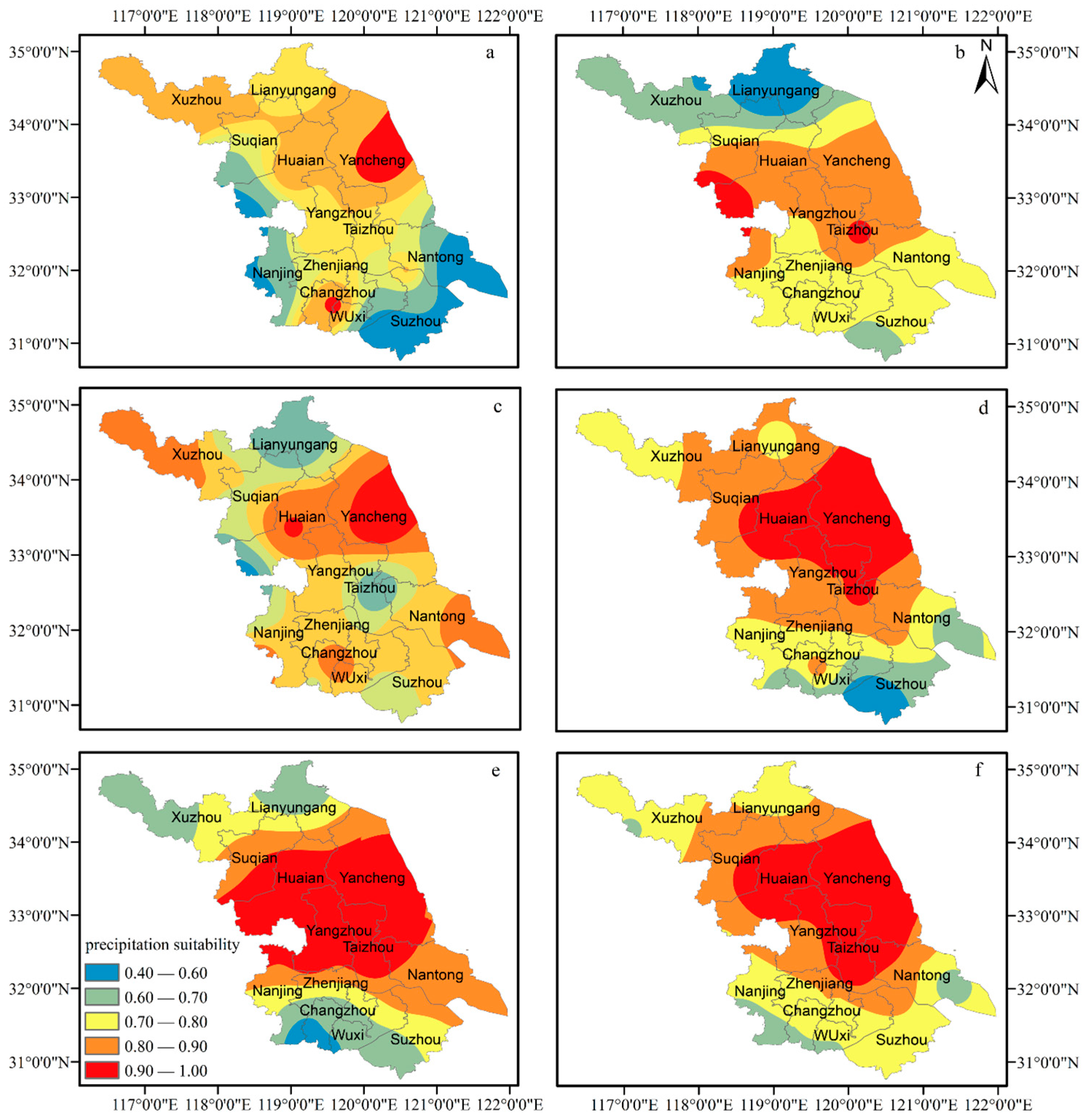
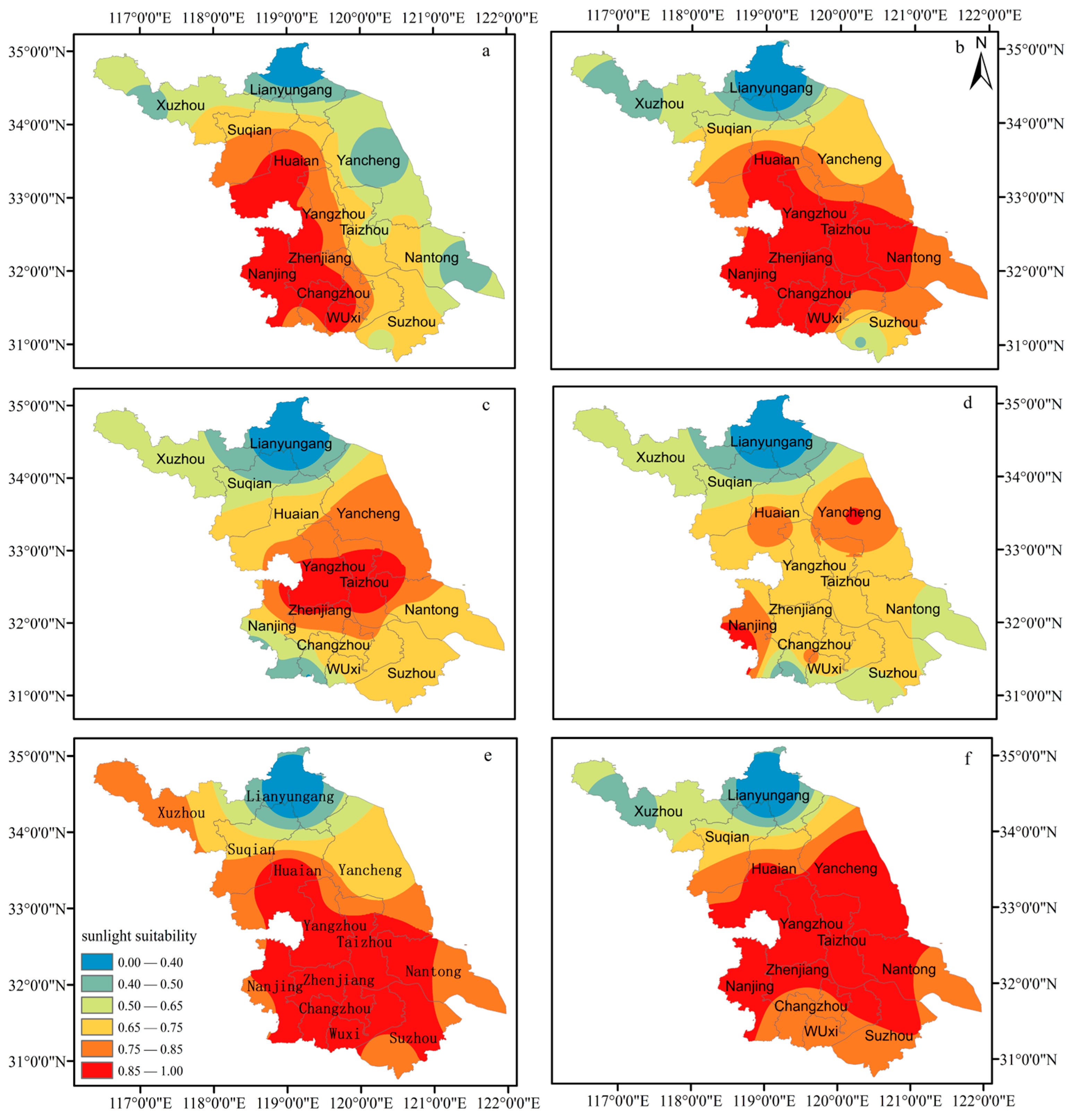
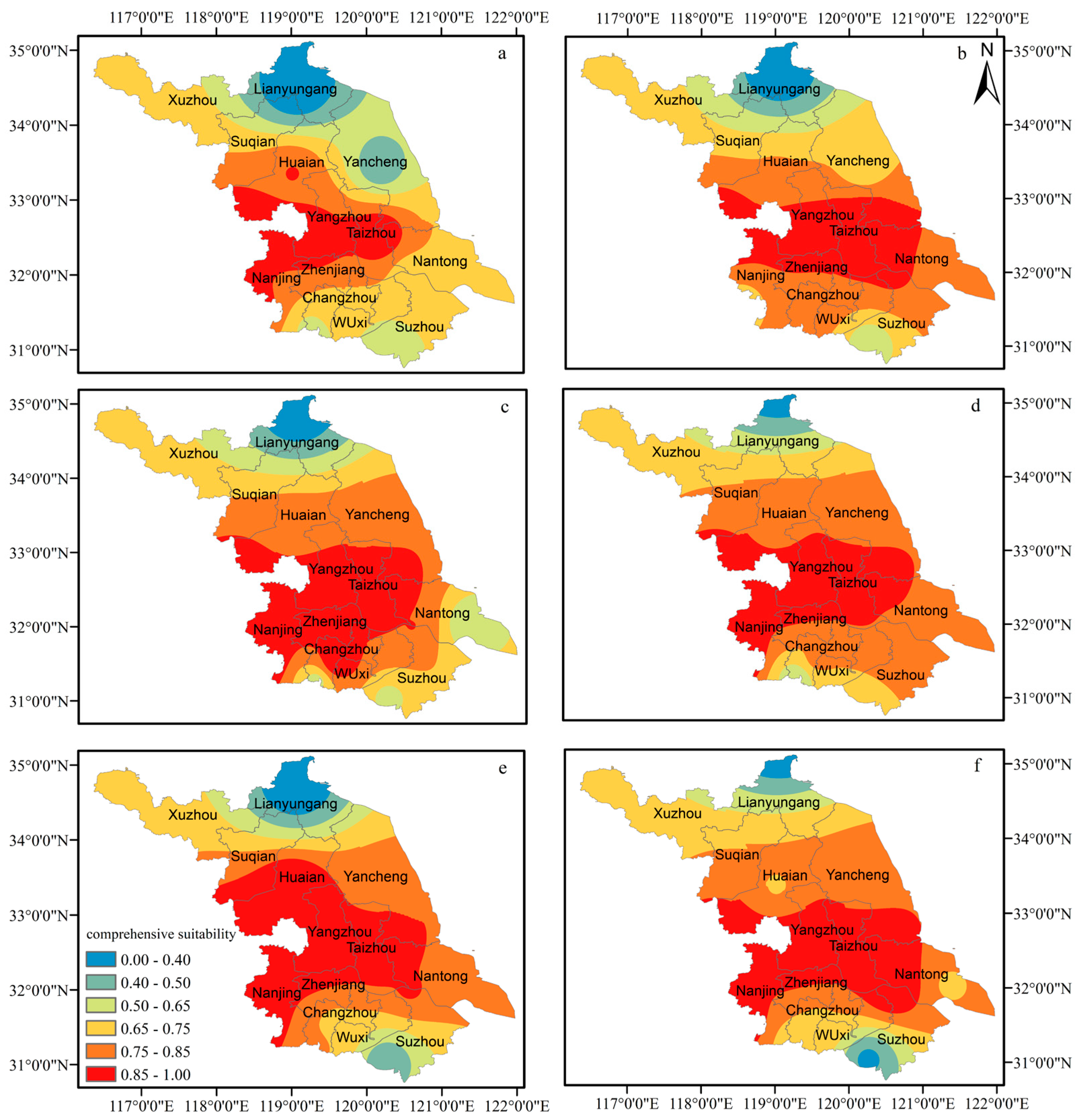
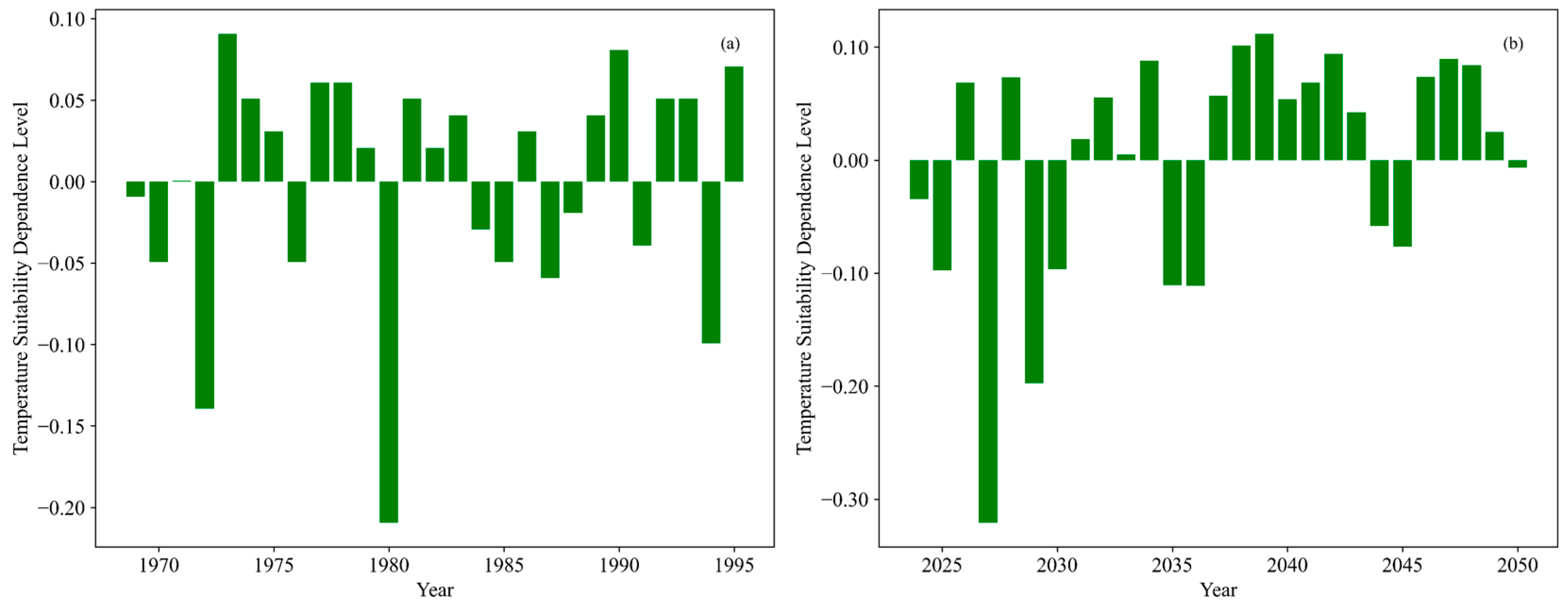
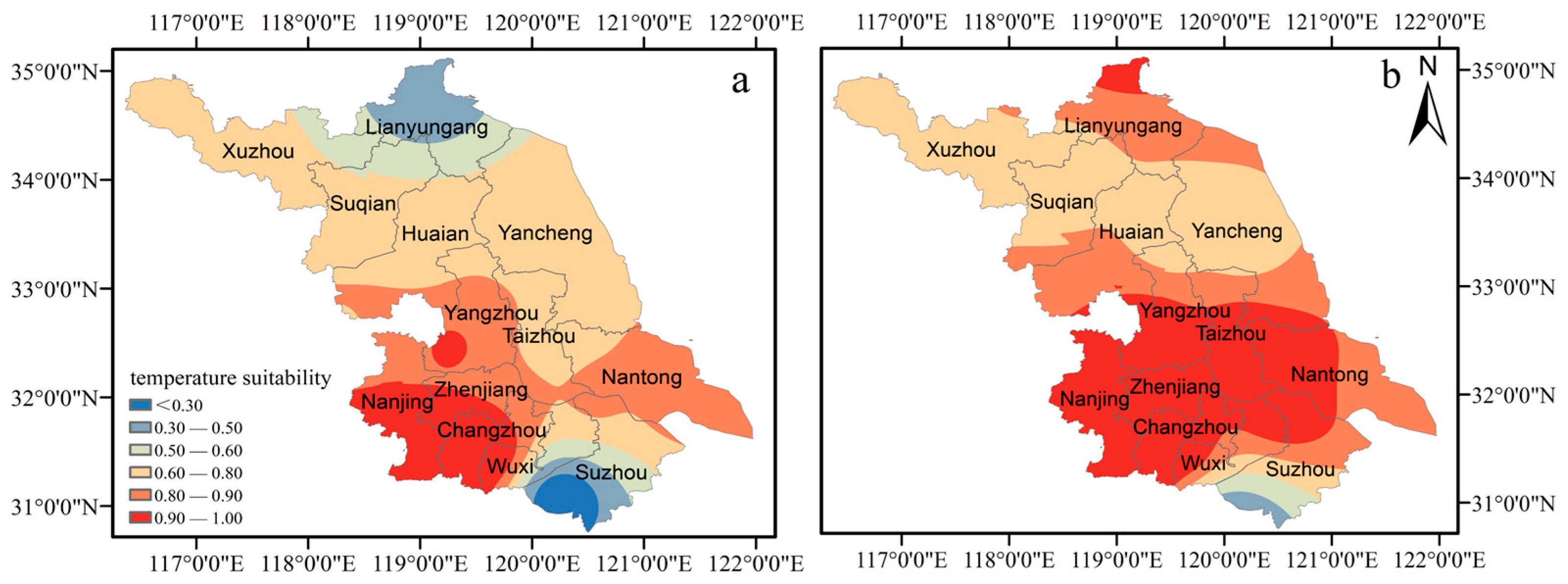

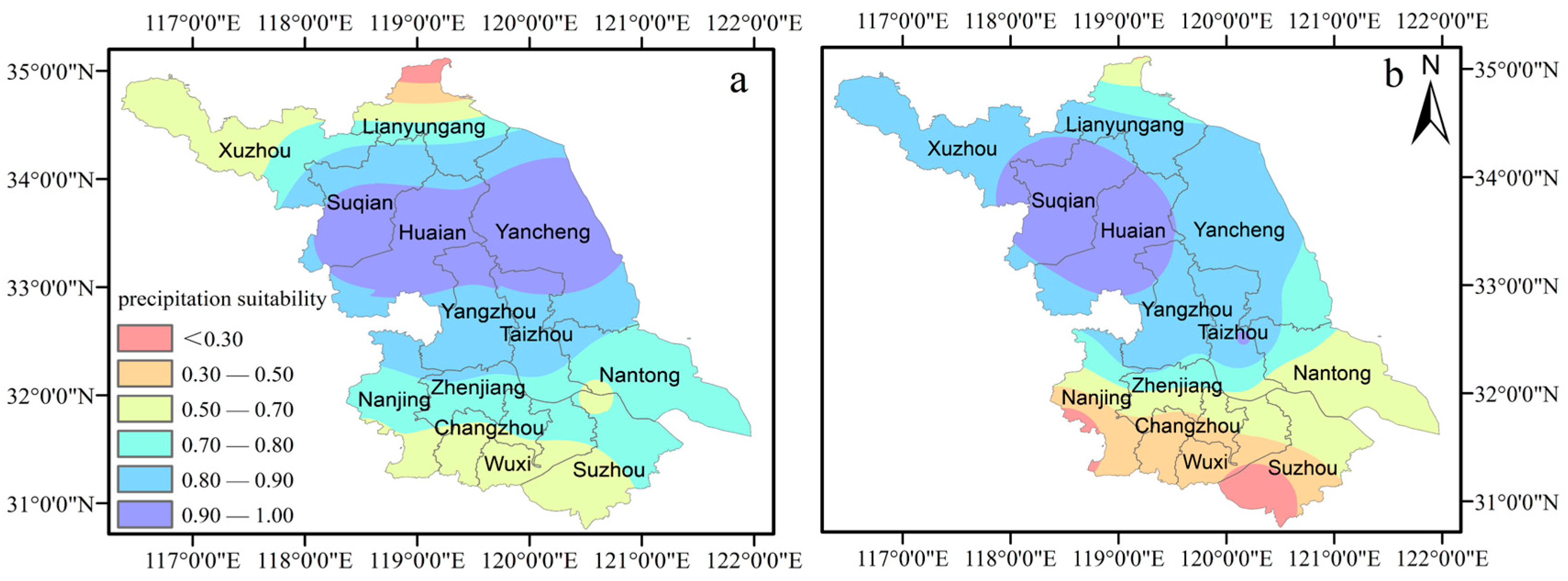
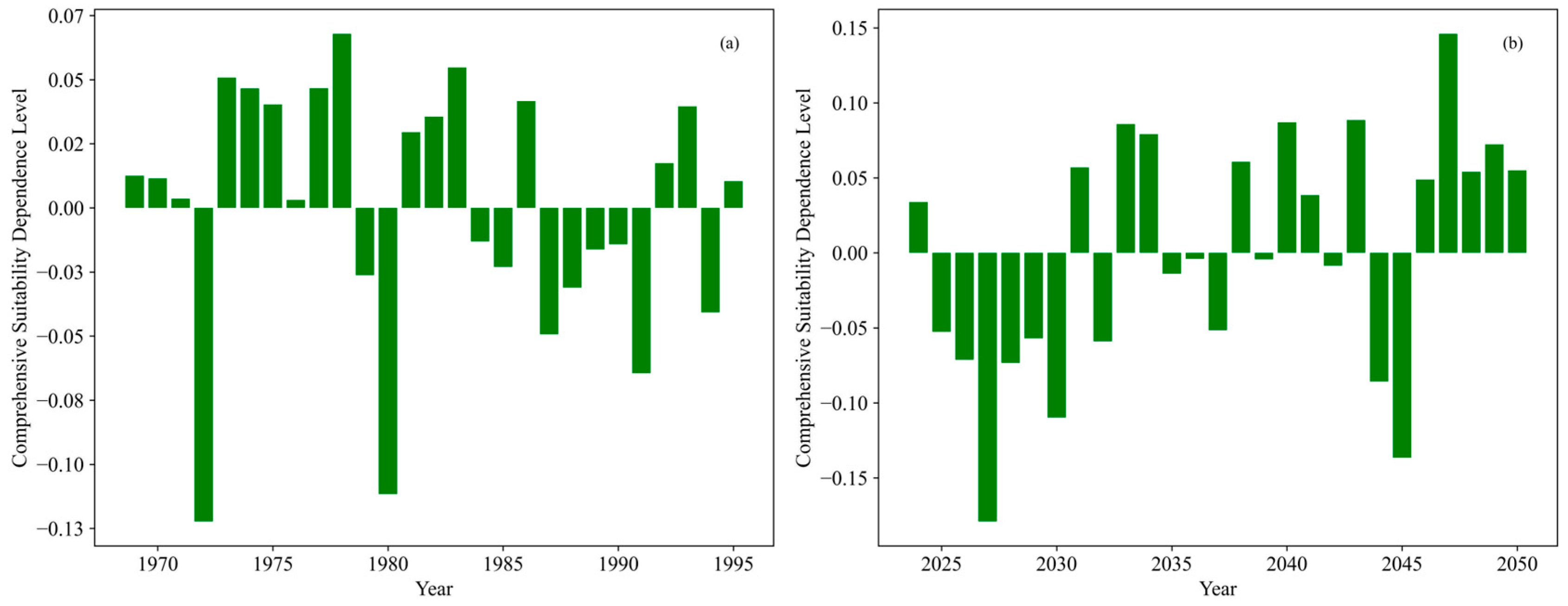
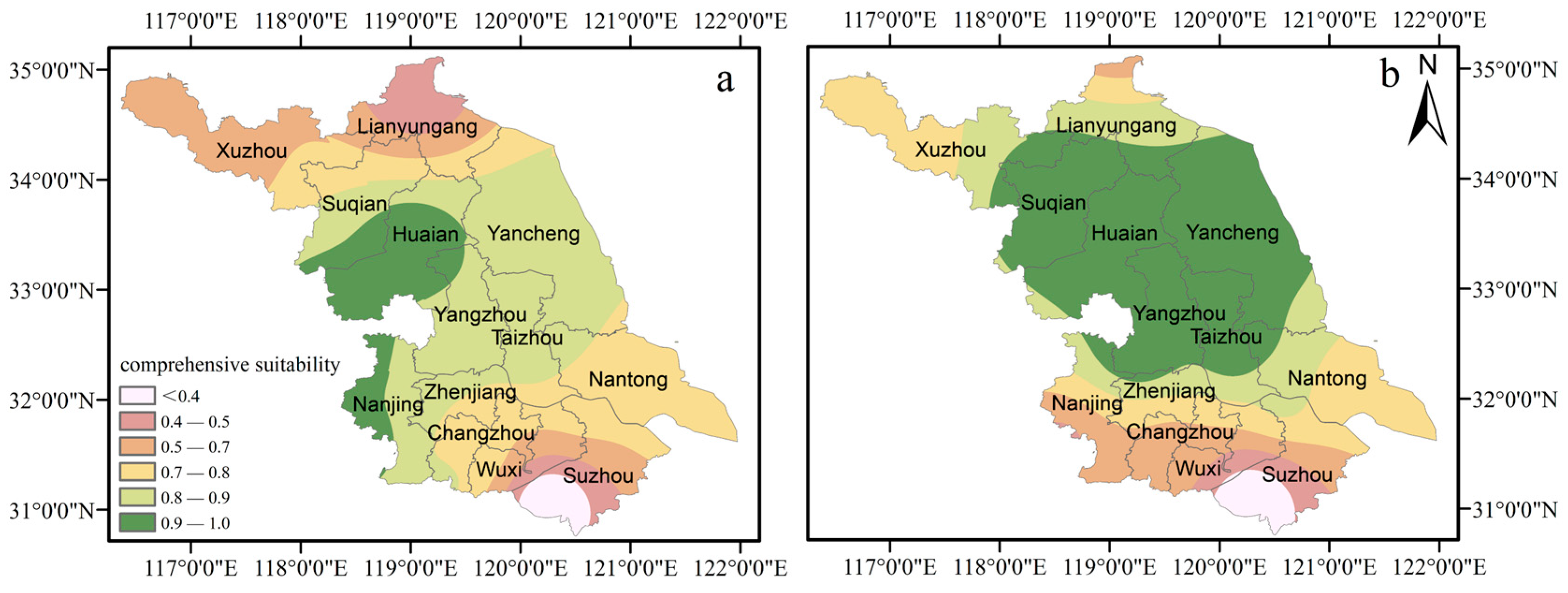
| Growth Stage | Period | Three Base Point Temperature T (°C) | ||
|---|---|---|---|---|
| t0 | t1 | t2 | ||
| Seedling | September 15–November 30 | 15 | 12 | 25 |
| Overwintering | December 1–February 15 | 2 | −3 | 8 |
| Bud and shoot | February 16–March 15 | 8 | 1 | 10 |
| Flowering | March 16–April 30 | 16 | 10 | 20 |
| Maturity | May 1–May 31 | 20 | 15 | 24 |
Disclaimer/Publisher’s Note: The statements, opinions and data contained in all publications are solely those of the individual author(s) and contributor(s) and not of MDPI and/or the editor(s). MDPI and/or the editor(s) disclaim responsibility for any injury to people or property resulting from any ideas, methods, instructions or products referred to in the content. |
© 2025 by the authors. Licensee MDPI, Basel, Switzerland. This article is an open access article distributed under the terms and conditions of the Creative Commons Attribution (CC BY) license (https://creativecommons.org/licenses/by/4.0/).
Share and Cite
Shi, Y.; Zhu, Q.; Zhu, M.; Jiang, N.; Ren, L.; Lou, Y. Impact of Climate Change on the Climatic Suitability of Oilseed Rape (Brassica napus L.) Planting in Jiangsu Province, China. Agriculture 2025, 15, 1900. https://doi.org/10.3390/agriculture15171900
Shi Y, Zhu Q, Zhu M, Jiang N, Ren L, Lou Y. Impact of Climate Change on the Climatic Suitability of Oilseed Rape (Brassica napus L.) Planting in Jiangsu Province, China. Agriculture. 2025; 15(17):1900. https://doi.org/10.3390/agriculture15171900
Chicago/Turabian StyleShi, Yuqing, Qichun Zhu, Mengquan Zhu, Nan Jiang, Lixuan Ren, and Yunsheng Lou. 2025. "Impact of Climate Change on the Climatic Suitability of Oilseed Rape (Brassica napus L.) Planting in Jiangsu Province, China" Agriculture 15, no. 17: 1900. https://doi.org/10.3390/agriculture15171900
APA StyleShi, Y., Zhu, Q., Zhu, M., Jiang, N., Ren, L., & Lou, Y. (2025). Impact of Climate Change on the Climatic Suitability of Oilseed Rape (Brassica napus L.) Planting in Jiangsu Province, China. Agriculture, 15(17), 1900. https://doi.org/10.3390/agriculture15171900




